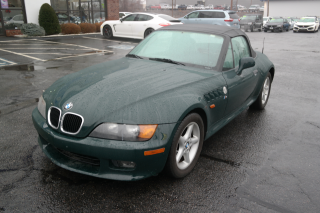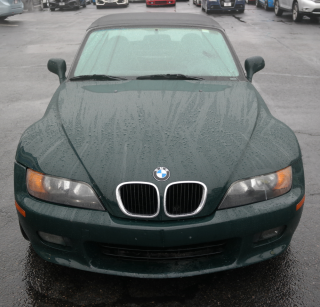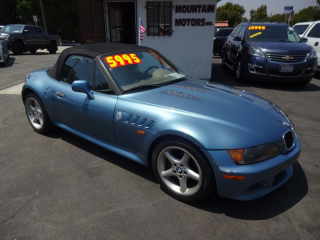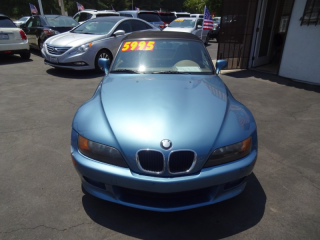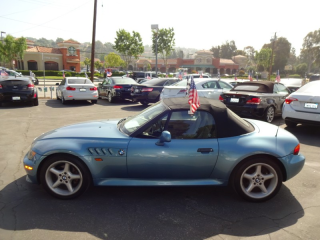The Good
The 1997 BMW Z3 offers an exhilarating driving experience with its nimble handling and responsive engines, appealing to emotional buyers seeking open-air thrills and BMW prestige. Its timeless roadster design remains attractive. Practically, the 4-cylinder models offer decent fuel efficiency, and it provides a strong value proposition in the used market for a classic, fun-to-drive sports car.
The Bad
Known weaknesses of the 1997 BMW Z3 include potential for rear subframe cracking, particularly in higher-powered models, and common cooling system failures (water pump, thermostat housing). VANOS unit issues can affect 6-cylinder engines. Interior plastics can degrade, and the convertible top mechanism requires careful inspection for wear and tear.
1997 BMW Z3: Quick Overview
- Engine Options: The 1997 BMW Z3 offered two primary engine choices for the US market: a 1.9-liter M44 DOHC 16-valve inline-4 cylinder, and a more potent 2.8-liter M52 DOHC 24-valve inline-6 cylinder.
- Horsepower: The 1.9L engine produced approximately 138 horsepower, while the 2.8L six-cylinder delivered a more robust 189 horsepower.
- Fuel Economy: Estimated EPA fuel economy figures were around 22-24 MPG combined for the 1.9L model, and roughly 20-22 MPG combined for the 2.8L model, varying with transmission and driving conditions.
- 0-60 MPH Times: Performance was respectable for its class; the 1.9L typically achieved 0-60 mph in about 8.5-9.0 seconds, while the 2.8L significantly quicker at approximately 6.5-7.0 seconds.
- Towing Capacity: The BMW Z3 is a two-seater roadster and is not officially rated or recommended for towing.
- Trim-Level Features:
- Z3 1.9: Standard features included a manual soft top, power windows, power mirrors, an AM/FM cassette stereo, and leatherette upholstery. It typically rode on 16-inch alloy wheels. Optional features included air conditioning, leather seating surfaces, cruise control, heated seats, and a premium audio system.
- Z3 2.8: This trim added the powerful 2.8L 6-cylinder engine and was visually distinguished by wider rear fenders and broader rear tires. Standard equipment often included automatic stability control (ASC+T), full leather upholstery, air conditioning, and a more advanced audio system. It often came with 16-inch or optional 17-inch alloy wheels. Both models offered a choice between a 5-speed manual or a 4-speed automatic transmission. Anti-lock brakes (ABS) were standard on all Z3s.
1997 BMW Z3 Specifications
Vehicle Information
| Year | 1997 |
| Make | BMW |
| Model | Z3 |
| Trim | - |
| Style | - |
| Type | Convertible |
| Category | Compact Car |
Manufacturing Details
| Made In | United States |
| Manufacturing City | GREER |
Dimensions
| Doors | 2-Door |
| Curb Weight | - |
| Gross Vehicle Weight Rating | - |
| Overall Height | - |
| Overall Length | - |
| Overall Width | - |
| Wheelbase Length | - |
| Standard Seating | - |
Engine & Performance
| Engine | 2.8-L I6 |
| Engine Size | 2.8L |
| Engine Cylinders | 6 |
| Transmission | Automatic |
| Transmission Type | Automatic |
| Transmission Speeds | - |
| Drivetrain | Rear-Wheel Drive |
Additional Features
| Anti-Brake System | - |
| Steering Type | - |
Pricing
| Manufacturer Suggested Retail Price (MSRP) | - |
| Invoice Price | - |
| Delivery Charges | - |
Vehicle History Report
Specifications
History
Events
History Check
Check
Check
Check
Check
Listings
Recalls
Check
Analysis
What Problems Does the 1997 BMW Z3 Have?
One of the most critical and widely recognized issues is the rear subframe cracking. This structural problem, where the differential mounting points can tear away from the chassis floor, is particularly prevalent in pre-facelift models (including 1997) and more powerful variants like the 2.8L. Owners should thoroughly inspect this area, as repairs can be extensive and costly.
The cooling system is another common Achilles' heel for many BMWs of this era, and the Z3 is no exception. Plastic components such as the water pump impeller, thermostat housing, and radiator end tanks become brittle with age and heat cycles, leading to leaks and potential overheating if not proactively replaced.
For models equipped with the 2.8L M52 inline-six engine, issues with the VANOS (Variable Nockenwellen Steuerung) unit can arise. Worn seals inside the unit can cause rattles, reduced power, or rough idling.
Electrical gremlins are also not uncommon, manifesting as failing window regulators, intermittent dashboard lights, or issues with the central locking system. The convertible soft top mechanism, whether manual or power-assisted, can suffer from brittle plastic components that break, hindering operation or leading to leaks. The rear plastic window is also prone to yellowing and cracking.
Inside, the interior plastics can become brittle over time, especially around the center console and door panels, leading to cracks or faded appearance. Seat bushings also tend to wear, causing a noticeable wobble in the seats. While there haven't been extensive, model-year-specific recalls for the 1997 Z3 beyond general BMW safety-related items (like airbag or fuel pump campaigns affecting broader vehicle ranges), these persistent age-related and design-specific issues warrant careful consideration for potential owners.
How long will the 1997 BMW Z3 last?
Over time, the notorious rear subframe cracking becomes a serious concern, particularly for models driven hard or those with higher mileage. The entire cooling system, comprised of many plastic components, will require a complete overhaul to prevent catastrophic failure. VANOS units on 6-cylinder models will likely need seal replacement. Suspension bushings, ball joints, and control arms will inevitably wear out, affecting handling. Additionally, convertible top mechanisms and interior plastics will show significant wear and degradation, requiring repair or replacement to maintain aesthetics and functionality.
What Technology & Safety Features are Included?
Built-in Tech and Entertainment: Standard features included power windows, power mirrors, and an AM/FM cassette stereo system. Many owners opted for air conditioning, which was often an extra. Optional entertainment enhancements included a trunk-mounted CD changer and a premium sound system for improved audio quality. Some higher trims or specific option packages might have included a basic onboard computer with limited functions, such as exterior temperature and time. Cruise control was also an available option, enhancing long-distance driving comfort.
Driver-Assistance Features: Driver assistance was fairly rudimentary. The most significant standard feature was Anti-lock Braking System (ABS), providing improved braking control during emergency stops. For the 2.8L models, Automatic Stability Control + Traction (ASC+T) was available, which helped manage wheel spin and maintain vehicle stability under challenging driving conditions, a precursor to more advanced stability control systems. This system could be turned off by the driver for a more engaging, unassisted driving experience.
Safety Features: In terms of passive safety, the 1997 Z3 came standard with dual front airbags for both the driver and passenger, along with three-point seatbelts equipped with pyrotechnic pretensioners. While not universally standard, many Z3s were optioned with or came to include integrated roll-over protection bars (often referred to as roll hoops) positioned behind the seats, offering some occupant protection in the event of a rollover accident. However, these were not present on all early models.
Crash-Test Ratings: Comprehensive crash-test ratings from independent organizations like NHTSA or IIHS for the 1997 BMW Z3 are not readily available in the same standardized format as for contemporary vehicles. Low-volume sports cars of that era often met federal safety standards through manufacturer internal testing rather than undergoing extensive public crash testing. Prospective buyers should assume safety technology is limited compared to modern standards.
What Colors Options are Available?
1997 BMW Z3 Prices and Market Value
Today, the used market prices for a 1997 Z3 are highly variable. Examples in fair condition might fetch $3,000 to $6,000, while well-maintained, good-condition cars often sell for $7,000 to $12,000. Exceptional, low-mileage, or highly sought-after examples, particularly the 2.8L with a manual transmission, can command $15,000 to $25,000 or more, showing signs of appreciation as a modern classic.
Factors significantly affecting resale value include the overall mechanical and cosmetic condition, verifiable maintenance records (especially addressing common Z3 issues like the subframe and cooling system), mileage, and engine choice (the 2.8L is generally more desirable). The presence of a manual transmission and appealing color combinations also contribute positively to its value in the enthusiast market, indicating a transition from pure depreciation to collectible status.
1997 BMW Z3 Cost of Ownership
Maintenance and repair costs can be significant. BMW parts are generally more expensive than those for mass-market vehicles, and specialized labor is often preferred. Proactively addressing known issues like cooling system overhauls, VANOS repairs, and inspecting for subframe cracking is crucial but can be costly. While the initial purchase price is low, owners should budget for ongoing "BMW tax" for parts and skilled mechanics. Therefore, it's more costly to own than a typical economy car but offers a rewarding driving experience for the investment.
1997 BMW Z3 Fuel Efficiency
1997 BMW Z3 Recalls & Defects
Vehicle Speed Control
Exterior Lighting
1997 BMW Z3 Insurance
reasonable repair costs.
How Does the 1997 BMW Z3 Compare to Other Convertible?
In terms of performance, the Z3 1.9 is comparable to the Mazda Miata, offering a spirited but not overwhelmingly powerful experience. The Z3 2.8, however, significantly outpaces the Miata in straight-line acceleration, with its 189 hp six-cylinder. The Porsche Boxster, with its mid-engine layout and superior chassis, typically offers a more refined and capable handling experience, along with generally higher horsepower variants. The Mercedes-Benz SLK230 Kompressor provides a supercharged four-cylinder with good torque, often feeling more luxurious and less raw than the Z3.
Regarding features, the Z3 provides a classic BMW blend of sportiness and comfortable amenities, with options like leather, heated seats, and premium audio. The Miata is generally more spartan, focusing on lightweight purity. The SLK typically boasts more luxury-oriented features and, notably, introduced the innovative retractable hardtop, a significant advantage in terms of comfort and security. The Boxster, being a Porsche, was positioned as a more premium offering with a higher level of fit and finish.
Reliability is a key differentiator. The Mazda MX-5 Miata is widely regarded as one of the most reliable sports cars ever made. The Z3, while generally robust, has well-documented issues such as cooling system failures, VANOS problems on 6-cylinder engines, and crucially, potential rear subframe cracking. The Porsche Boxster 986 can suffer from expensive engine issues, most notably the IMS bearing failure. The SLK R170 is generally robust but can have issues with its supercharger and retractable hardtop mechanism as it ages.
Price when new saw the Miata as the most affordable, followed by the Z3, then the SLK, and the Boxster as the most expensive. In the current used market, this hierarchy generally holds, though specific condition and mileage can cause significant deviations.
Alternatives: For ultimate reliability and a pure, lightweight driving experience, the Mazda MX-5 Miata (NA or NB generation) is an excellent, more economical alternative. If performance and prestige are paramount and the budget allows for potential major engine work, the Porsche Boxster offers a superior driving dynamic. For those seeking more luxury and an all-weather convertible, the Mercedes-Benz SLK is a similar, albeit different, proposition.
Final Verdict: Is the 1997 BMW Z3 a Good Convertible?
It is certainly worth buying, but under specific conditions. As a used vehicle, its current market value offers significant charm for the money. Prospective buyers should prioritize the 2.8L model for its enhanced performance and more desirable aesthetic, though the 1.9L remains a fun and more economical option. A thorough pre-purchase inspection (PPI) is absolutely critical, focusing on the notorious rear subframe, the condition of the cooling system, and the convertible top mechanism. Buyers must budget for potential deferred maintenance and proactive replacement of wear items. When found in well-maintained condition with comprehensive service records, the 1997 Z3 offers an immensely rewarding ownership experience that embodies the spirit of a classic sports car.
